Groundwater
dating by CFC and SF6 (France)
GROUNDWATER
Download the practice
People in charge of the innovative practice :
Virginie VERGNAUD – virginie.vergnaud@univ-rennes1.fr
Groundwater dating by chlorofluorocarbon (CFC) and sulfur hexafluoride (SF6) dating is a geochemical analysis methodology for estimating the mean turnover time of groundwater. This methodology is developed by the CONDATE-Eau platform of the University of Rennes 1 in France. This expertise is carried by only 8 laboratories in the world, and allows a fine analysis (in picograms per liter), where conventional analyses are generally in micrograms per liter. The use of these tracers allows the understanding of the functioning of aquifer systems via circulation models. CFCs are gases known for their impact on the ozone layer, and there are no more emitting countries. There are three main sources of CFC emissions: polystyrene foams (CFC-11); refrigerators (CFC-12); and solvents (CFC-113). SF6 is used as an electrical insulator. This methodology was developed in groundwater following the intensification of agricultural practices in the 1970-1980s and a significant increase in nitrate releases. The objective of this methodology was to estimate the residence time of nitrates that move at the same speed as water. The tool is now used by communities, engineering companies, and university laboratories as a management tool for aquifer systems to reveal the time needed before observing the effects of action programs aimed at limiting nitrate inputs on a territory. It is also a communication tool for farmers and field actors to show them the time frame in which the results of their efforts will be visible.
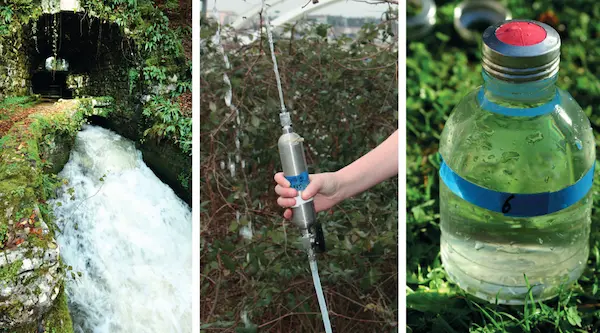
Responsible entity
The CONDATE-Eau Platform is the entity responsible for this innovative management practice. It is a platform of the University of Rennes 1 that offers services in hydrogeology and residence time estimation to communities, engineering agencies, and other academic partners.
Institutional setting
Since 2000, the Water Framework Directive (WFD) has set ambitious objectives in terms of restoring the quality of water resources (whether they are intended for drinking water supply or not). Within the framework of this directive, the member states of the European Union must act in particular to protect their drinking water catchments in order to reduce the treatments applied to the water extracted and to fight against the deterioration of the quality of the resource. The water bodies used for water catchments for human consumption (or which may be used in the future) are listed as protected areas. In France, the law on water and aquatic environments (LEMA, n°2006-1772, article 21) and the decree of 14 May 2007 (n°2007-888) have reinforced the existing regulatory tools. These texts have made it possible to use the “Environmentally Restricted Areas” (ERA) system on catchments. This device can be used on the scale of the catchment area (AAC is the French term) presenting a particular challenge for the current or future supply of drinking water (quantitative and qualitative protection of drinking water catchments). Subsequently, the Grenelle Environment Forum confirmed the importance of the protection of water catchments intended for drinking water supply. The implementation of the Grenelle conclusions (article 27 of the law n°2009-967 of August 3, 2009) thus provides for the protection of a little more than 500 catchments among those most threatened by diffuse pollution as of 2012.
Geographical setting
The practice is carried out on all types of aquifers on an international scale. Several examples of the use of this practice have been carried out in France, Brazil, India, Quebec, etc. There are about 30 projects per year on average of groundwater dating by CFC and SF6, of which 15% are carried out on an international scale.
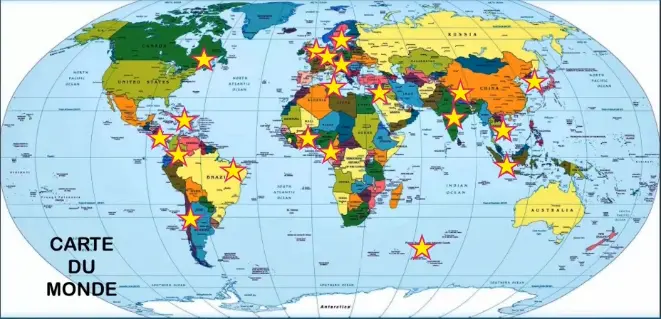
Detailed explanation
The estimation of the mean turnover time of groundwater is a geochemical analysis methodology that allows the dating of groundwater from CFC and SF6 gases. The principle is that these tracers tell us the time it took for the water to travel between its point of infiltration and its point of withdrawal. Indeed, once the gases are dissolved in the water table, they isolate themselves and keep their atmospheric signature.
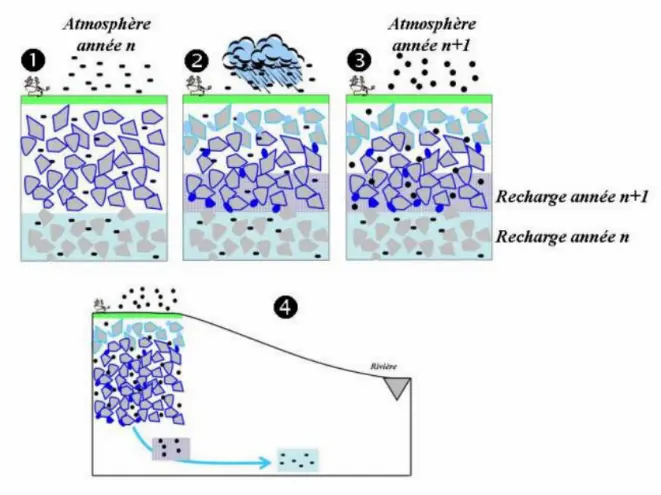
Figure 3: Schematic diagram of CFC and SF6 dating: recording the atmospheric signature.
However, a catchment is fed by a multitude of water drops that have different ages, so we can only estimate the average renewal time of the water table as a whole, we thus speak of average age or apparent age.
The understanding of aquifer functioning is thus achieved via circulation models observed in the environment, which represent either open aquifers, confined aquifers, or a mixture of both. The average age of the water table is then interpreted on the basis of 3 simple hydrogeological models: (i) piston, (ii) continuous recharge, and (iii) binary mixing.
For the piston model, all water lines have the same age and therefore all tracers are consistent. The recharge zone is then localized and isolated during the groundwater flow.
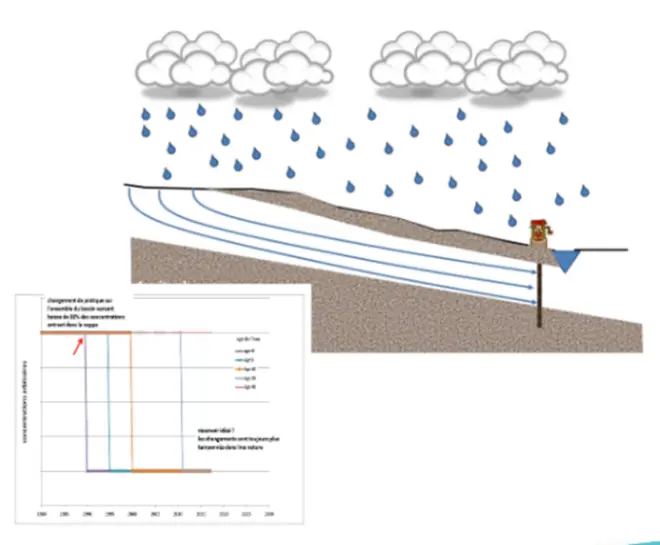
Figure 4: Piston circulation model.
For the exponential or continuous recharge model: the recharge is carried out on the whole catchment area at a given point, i.e. a mixture of water of all ages, the distribution thus corresponds to an exponential distribution. The time obtained is the average age for which 2/3 of the water table has been renewed.
For the binary mixing model, it is a mixture between two distinct and restricted recharge zone water masses in its simplest form. It can be infinitely complexified.
Historical overview
- 2005: first work on CFC dissolved gases in the framework of a regional project. This period also corresponds to the end of the thesis of V.Ayraud-Vergnaud on the estimation of water residence times in relation to algae in Brittany.
- 2007: creation of the LADES (Laboratoire de Datation des Eaux Souterraines) consultancy for the estimation of water residence times for communities. Valorization of the thesis work via a Young University Company.
- 2010: closing of the company and beginning of autonomy of the universities.
- 2011: Opening of the CONDATE-Eau platform within the University of Rennes 1 (OSUR-Observatoire des Sciences de l’Univers de Rennes – CNRS-UR1).
The main key factors of implementation were the Grenelle II law (n°2010-788) of July 12, 2010 and the need to delimit the protection areas of the catchments for drinking water and to set up action programs on these catchment areas.
The main obstacles were the lack of lobbying, as the estimation of the groundwater residence time was not imposed, and the financial leverage as this innovative method requires an expertise with a certain cost that can slow down its use.
Evidence of benefits from implementation
The main advantage of using this methodology is the homogeneity of the gas releases on an international scale. Indeed, we know the evolution curves of the release of these products which are homogeneous on the whole Northern hemisphere. These gases, banned since the Kyoto Protocol and Montreal in 1992, are very stable gases that have remained in the atmosphere.
Several references (thesis, platform website, institutional reports) demonstrate the interest of using these groundwater dating methodologies for the management of aquifer systems.
Replication potential in SUDOE region
The methodology has a strong potential for replication with more than 50 international references. But beware that this methodology cannot be extrapolated to pesticides which have different transfer times from water.
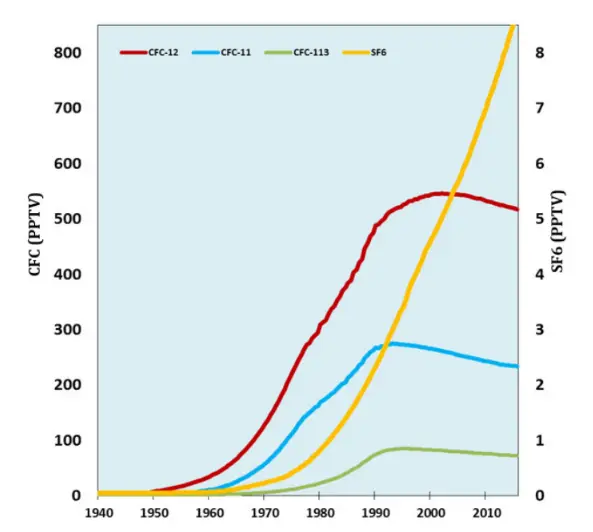
Figure 5: Chronic air concentrations of CFCs and SF6 in the Northern Hemisphere.
The implementation of this practice required the purchase of equipment (100 k€), the launch of a thesis, the recruitment of a study engineer (1 full-time) for development, and the presence of a research engineer.
Today, the human resources dedicated to the management of the practice are 4 people (2 full-time), with a study engineer on a fixed-term contract for logistics and analyses, and a research engineer on a permanent contract for coordination. Finally, two other research engineers are needed for R&D developments.
Water dating services for local authorities can be subsidized by the water agencies, up to 50-80%. The equipment (investment and renewal) can be subsidized by the State-Region Plan Contracts.
Future outlook
In the short term, the prospects for development are to move on to other types of studies: (i) tracing and measurement by continuous dissolved gas, and (ii) organic geochemistry for the identification of faecal contamination. For the long term, the objective is the monitoring of emerging gases, but technical barriers must be removed because they are not persistent in the atmosphere.
Key points of the innovative method
> Estimation of aquifer turnover time via CFC and SF6 tracers
> High replication potential: all types of aquifers on an international scale
> Evaluate the reactivity of the aquifer to recharge modalities
> Evaluate the time necessary before being able to observe the impacts of action programs
Acknowledgements
The innovative practice was suggested by Yvan KEDAJ (Aqua-Valley) and Virginie VERGNAUD (University of Rennes 1) participated in the interviews.
References
Ayraud, V. (2015). Détermination du temps de résidence des eaux souterraines : application au transfert d’azote dans les aquifères fracturés hétérogènes. Thèse de doctorat, Universités Rennes 1, France, 313 p. https://tel.archives-ouvertes.fr/tel-00088100/document – Consulté en ligne le 24 janvier 2022.
Antea-Group (2019). Estimation du temps moyen de renouvellement de l’eau par datation à partir des CFC et SF6. Résultats 2018 sur les captages prioritaires en eau souterraines du Sud du bassin. https://www.eaurmc.fr/upload/docs/application/pdf/2019-05/rapport-datation-2018_sud-bassin-rm-vf.pdf – Consulté en ligne le 24 janvier 2022.
Depardon, S., & Vergnaud, V. (2018). Estimation des délais de renouvellement des aquifères : méthodes et premiers résultats sur les captages du bassin Rhône Méditerranée. Une aide pour orienter les opérations de restauration de la qualité ? Journée eau & connaissance, Université Lumière Lyon 2, le 6 décembre 2018. https://docplayer.fr/144441949-Depardon-stephane-antea-group-vergnaud-virginie-plateforme-condate-eau-osur-univ-rennes.html – Consulté en ligne 24 janvier 2022.
INTERNET REFERENCES:
Plate-forme Condate-Eau : https://osur.univ-rennes1.fr/condate-eau
Protection des captages contre les pollutions diffuses : le contexte réglementaire. https://aires-captages.fr/page/contexte-reglementaire
aquifer
news
Discover more on the Aquifer project news and on aquifer management
aquifer news
Description and objectives of the project
The scientific community recommends a substantial improvement in the knowledge of aquifers, the establishment of reliable monitoring networks and a greater involvement of the administration and users to achieve a sustainable management of aquifers. The main objective...
Information on the project
The Llobregat Delta Water Users' Community has designed recharge basins in Molins de Rei to recharge the Baix Llobregat aquifer. View of one of the reloading basins during the test phase The Llobregat Delta Water Users' Community is one of the nine partners in the...
Success stories in groundwater management
Compilation of groundwater management success stories completed. Throughout April, the 30 cases of innovative practices in groundwater management have already been selected by the clusters participating in the project: PPA, CWP and AV. The task started with the...
PROPOSE AN
INNOVATIVE PRACTICE
You are in charge of an innovative practice regarding aquifer management and you want to referenced it on the Aquifer platform ?
Fulfill the form and propose it to the Aquifer partners.
THE EBOOK
Aquifer offers a range of innovative water management practices. You can download all our fact sheets here.
e-book of innovative practices
DOCUMENTATION
To go further on information related to the management of aquifers